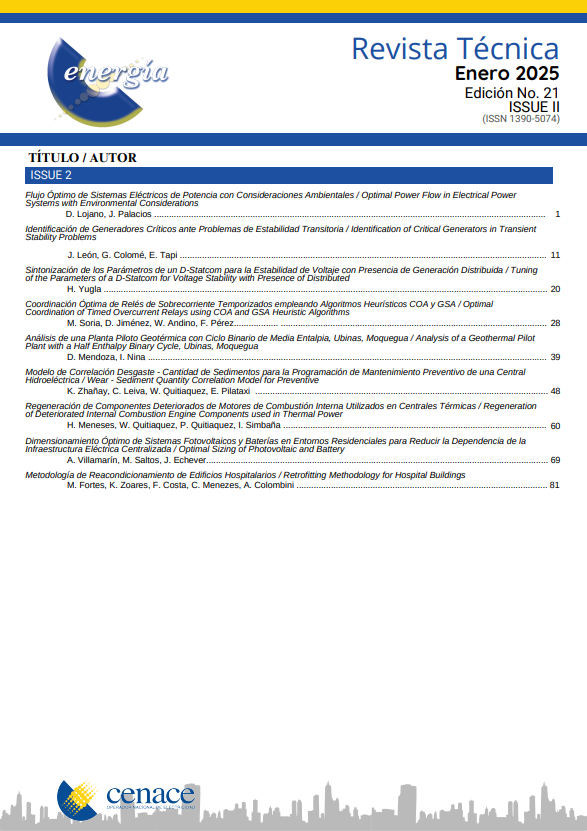Optimal Sizing of Photovoltaic and Battery Energy Systems in Residential Environments to Reduce Dependence on Centralized Electricity Infrastructure
Main Article Content
Abstract
Distributed Energy Resources (DERs) offer an effective alternative to reduce reliance on centralized electrical infrastructure by providing a more decentralized and flexible energy supply. This work presents an optimization model using mixed-integer linear programming (MILP) to determine the optimal sizing of DERs integrating photovoltaic generation and battery storage, designed to operate both connected to the grid and autonomously. Using real data on energy resources, demand, and construction characteristics of an urban residential complex, the study shows that DERs can significantly reduce dependence on the main grid. Furthermore, it optimizes the use of renewable resources, promoting greater energy self-sufficiency. The methodology is adaptable to various urban settings, where implementing DERs enables increased energy independence, relieving the load on centralized infrastructure and ensuring a reliable supply despite fluctuations in grid availability.
Downloads
Article Details

This work is licensed under a Creative Commons Attribution-NonCommercial 4.0 International License.
Aviso de Derechos de Autor
La Revista Técnica "energía" está bajo licencia internacional Creative Commons Reconocimiento-NoComercial 4.0.
References
International Energy Agency (IEA), “World Energy Outlook 2022” 2022, [Online]. Available: https://iea.blob.core.windows.net/assets/830fe099-5530-48f2-a7c1-11f35d510983/WorldEnergyOutlook2022.pdf
Central Intelligence Agency (CIA), “World Factbook Urbanization.” 2023, [Online]. Available: https://www.cia.gov/the-world-factbook/field/urbanization/
CNN, “Apagones por la sequía en Ecuador.” 2023, [Online]. Available: https://cnnespanol.cnn.com/2023/10/26/ecuador-apagones-sequia-cuando-empiezan-horarios-orix/.
World Meteorological Organization (WMO), “State of the Climate in Latin America and the Caribbean 2022” 2023, [Online]. Available: https://wmo.int/publication-series/state-of-climate-latin-america-and-caribbean-2022
Energy Information Administration (EIA), “Residential Energy Consumption Survey (RECS)” 2024, [Online]. Available: https://www.eia.gov/consumption/residential/
M. Saltos, A. Velásquez, M. Aguirre, A. Villamarín, D. Ortíz, y R. Haro, «Planificación Óptima de Recursos Energéticos Distribuidos para Mejorar la Resiliencia de Sistemas de Distribución de Energía Eléctrica frente a Desastres Naturales: Caso en Lahares Volcánicos», re, vol. 18, n.º 2, pp. PP. 13–24, ene. 2022.
T. Sidnell, F. Clarke, B. Dorneanu, E. Mechleri and H. Arellano-Garcia, "Optimal design and operation of distributed energy resources systems for residential neighbourhoods," in Smart Energy, vol. 4, pp. 100049, Nov. 2021.
N. S. Kelepouris, A. I. Nousdilis, A. S. Bouhouras and G. C. Christoforidis, "Cost-Effective Hybrid PV-Battery Systems in Buildings Under Demand Side Management Application," in IEEE Transactions on Industry Applications, vol. 58, no. 5, pp. 6519-6528, Sept.-Oct. 2022.
R. Khezri, A. Mahmoudi and H. Aki, " Optimal planning of solar photovoltaic and battery storage systems for grid-connected residential sector: Review, challenges and new perspectives," in Renewable and Sustainable Energy Reviews, vol. 153, pp. 111763, Jan. 2022.
J. Koskela, A. Rautiainen and P. Järventausta, " Using electrical energy storage in residential buildings – Sizing of battery and photovoltaic panels based on electricity cost optimization," in Applied Energy, vol. 239, pp. 1175-1189, Apr. 2019.
Ministerio de Energía y Minas, "Plan Maestro de Electricidad 2023-2032", 2024. [Online]. Available: https://www.recursosyenergia.gob.ec/plan-maestro-de-electricidad/
ARCERNNR, “REGULACIÓN Nro. ARCERNNR 001/2021, Marco normativo de la Generación Distribuida para autoabastecimiento de consumidores regulados de energía eléctrica.” 2021, [Online]. Available: https://www.controlrecursosyenergia.gob.ec/wpcontent/uploads/downloads/2021/06/res_nro__arcer nnr-013-2021.pdf
S. Mashayekh, M. Stadler, G. Cardoso and M. Heleno, "A mixed integer linear programming approach for optimal DER portfolio, sizing, and placement in multi-energy microgrids," in Applied Energy, vol. 187, pp. 154-168, Feb. 2017.
A. Scalfati, D. Iannuzzi, M. Fantauzzi and M. Roscia, "Optimal sizing of distributed energy resources in smart microgrids: A mixed integer linear programming formulation," 2017 IEEE 6th International Conference on Renewable Energy Research and Applications (ICRERA), San Diego, CA, USA, 2017, pp. 568-573.
A. Cosic, M. Stadler, M. Mansoor and M. Zellinger, "Mixed-integer linear programming based optimization strategies for renewable energy communities," in Energy, vol. 237, pp. 121559, Dec. 2021.
A. Velásquez-Lozano et al., "Practical Framework for Optimal Planning of Isolated Rural Microgrids," in Recent Advances in Electrical Engineering, Electronics and Energy, vol 931, pp. 227-241, 2022.
H. Mehrjerdi and R. Hemmati, “Modeling and optimal scheduling of battery energy storage systems in electric power distribution networks," Journal of Cleaner Production, vol. 234, pp. 810-821, 2019.
CNEL EP, “Geoportal.” 2023, [Online]. Available: https://geoportal.cnelep.gob.ec/cnel/#.
“PVGIS,” 2021, [Online]. Available: https://re.jrc.ec.europa.eu/pvg_tools/es/.
“FICO XPRESS Optimization Suite,” 2023, [Online]. Available: http://www.fico.com/en/products/.
Agencia de Regulación y Control de Energía, “Resolución Nro. ARCONEL-034/19” 2019, [Online]. Available: https://www.controlrecursosyenergia.gob.ec/wp-content/uploads/downloads/2021/02/Res-ARCONEL-034-19.pdf



